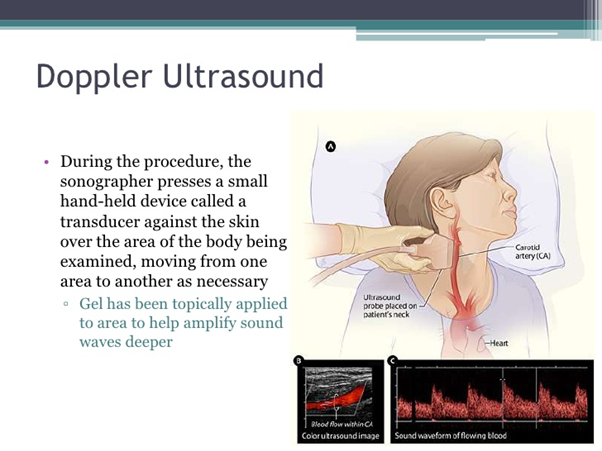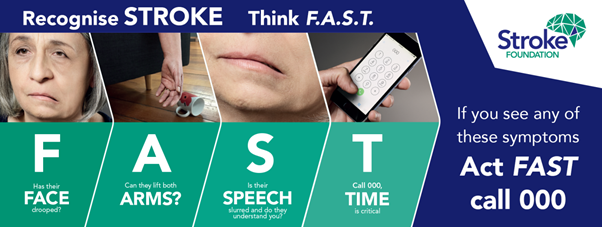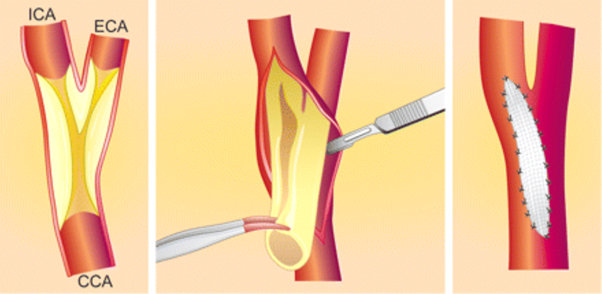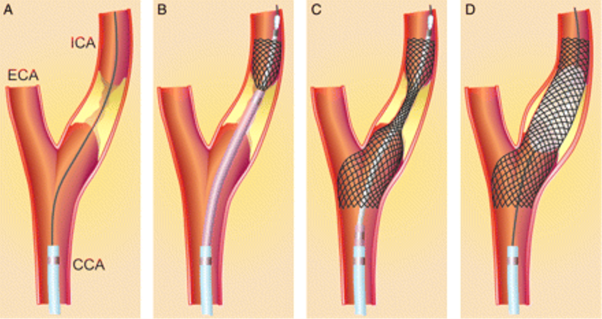What is carotid artery disease?
Carotid arteries are the large arteries in the front of your neck sitting beside the windpipe. They carry the majority of the blood supply to your brain. Hardening of the carotid arteries is the result of harmful build-up of fatty deposit in the artery. The fatty deposit (plaque) can become thicker with time causing narrowing of the artery. Some of the plaque can break off and travel in the blood and get stuck in a smaller artery in the brain causing that part of the brain to suffocate. This is called transient ischaemic attack (TIA) or stroke. A transient ischaemic attack (TIA) is like a stroke but the symptoms disappear within 24 hours. A TIA is often the warning sign that a stroke may follow. About 20% of all strokes are caused by carotid artery disease. The remaining 80% are often due to heart disease. You can calculate your risk of stroke or heart disease in the next five years by using the calculator provided at the Australian Vascular Disease Prevention Alliance website.

Figure1: Carotid artery disease causing stroke
What are the risk factors?
- Age
- Gender- more common in male
- Family history of early stroke, coronary artery disease or leg artery blockage
- Smoking
- Obesity
- Hypertension
- Hyperlipidemia- high total cholesterol and low high-density lipoprotein (HDL) cholesterol are independent risk factors
- Diabetes- poor glycaemic control predispose to peripheral arterial disease
- Sedentary lifestyle
- Depression
How is carotid artery disease diagnosed?
Carotid artery disease is usually diagnosed after a transient ischaemic attack (TIA) or stroke. There is no evidence to suggest screening for carotid disease is beneficial. This is due to the fact that surgical intervention only has a small effect in absolute risk reduction of stroke and hence many operations are needed to prevent one stroke (a lot of this operation is not necessary). Ultrasound of the carotid artery is most commonly used and is non-invasive. CT angiogram (Computer tomography) or MR angiogram (magnetic resonance imaging) can also be used to diagnosed and provide surgical intervention planning

Figure2: Carotid artery ultrasound
How is carotid artery disease treated?
If you noticed some one has a stroke, even if they subsequently recover. They need to attend the nearest emergency department. The signs of stroke are facial droop on one side of the face, weakness in the arm or legs, inability to speak properly and inability to see out of one eye for a short period of time (amaurosis fugax). Urgent assessment and treatment is required.

Figure 3: Recognizing stroke
Carotid endarterectomy is a very effective way to treat carotid artery disease. In this operation, the surgeon makes a cut in the neck to expose the carotid artery. A cut is then made on the carotid artery to remove the plaque (harmful build-up of fatty material) and the artery is widened by putting a patch of synthetic material or vein on it. This operation carries with it a small risk of stroke (1%) and injury to the nerve in the neck causing problem with coughing, swallowing, and voice production. The alternative option is carotid artery stenting. This option is minimally invasive, however the current technology has not mature enough to have this procedure done with as low a risk of stroke as compared to carotid endarterectomy. It may be suitable for selected group of patient with low risk lesion.

Figure 4: Carotid endarterectomy

Figure 5: Carotid artery stenting